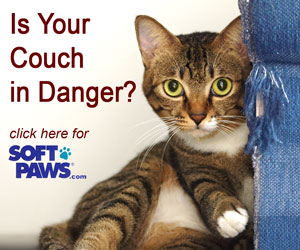Petting Induced Aggression in Cats

You've just settled down for a quiet evening in your favorite chair. As usual, your cat saunters up, purring and rubbing, demanding your attention. You reach up from your book and stroke her absentmindedly as you continue reading. Suddenly, and seemingly out of nowhere, your fickle feline is all teeth and claws. She savages your arm, then scurries away, hackles up, tail swishing. What on Earth just happened?
Your cat is showing signs of petting-induced aggression, a common behavioral issue in cats.
The amount of human interaction a cat enjoys varies significantly by individual. While some cats will sprawl out for belly rubs by the hour, others have strict limits on how much touching they allow and where. Most cats like being stroked on the head and neck. This may be because felines greet each other by rubbing or grooming in these areas. Physical contact on the lower back or belly is a different matter. It can signify a provocation or a threat. Some cats will just walk away when they've had enough. Others, seized by the competing desire for affection and escape, will lash out.
These attacks don't occur without warning. There are almost always clues. The cat's body gets tense. The tail twitches, the ears flatten, and the pupils dilate. The skin on the lower back may ripple. At this point, any further petting will cause the cat to react. Well-meaning cat lovers often miss these cues due to inattention or because it seems to be human nature to stroke a cat down the full length of the back. Young children may be especially prone to being victims of petting-induced aggression due to an inability to read feline body language and a tendency to avoid the head and pet the rear end instead.
Petting-induced aggression in cats is more than just a nuisance. Cat bites can cause serious injury. It can also become a self-perpetuating problem as the cat learns how effective her behavior is at putting unwanted petting to a stop.
Treatment of Petting-Induced Aggression in Cats
If you suspect that your cat has petting-induced aggression, the first step is to visit your veterinarian, especially if the behavior began suddenly. The doctor will conduct a full examination to rule out causes of pain or irritability that could make your cat wary of your touch. Examples include arthritis, dental disease, skin conditions, urinary tract infection, a thyroid disorder, or anal gland problems. A complete behavioral history may reveal contributing factors such as inadequate early socialization, conflicts with other pets in the house, or past trauma—such as a prior hip fracture or a tail that once got pinched in a door.
Once medical issues are addressed, it's time for behavior modification. Your veterinarian or veterinary behaviorist is likely to recommend a treatment plan such as the following:
- Learn the signs. Your cat will show signs of irritation or arousal just before she strikes. These include a suddenly tense body, dilated pupils, flattened ears, rippling back, and twitching tail.
- Determine your cat's petting threshold. Discover what triggers your cat's negative response. Is it when you rub her lower back? Go near the belly? After contact of any type that lasts more than a certain interval, say 20 seconds?
- Desensitize your cat. Learn to interact with your cat just short of her trigger point. When time is up, say "down" (yes, cats can learn simple voice commands). Place her gently on the floor and give a small food treat. Gradually increase the length of these petting sessions. Your cat will learn that calm interactions are controlled by you and followed by treats. In this way you are gradually shaping the behavior that you want.
- Never use physical punishment. Rough corrections will just intensify the problem. Vigorous handling during play sessions is a no-no as well.
Perhaps the hardest part of dealing with petting-induced aggression is accepting your cat's limits. What cat-lover doesn't adore snuggling up with a happy, purring cat and stroking their silky coat? Some cats just won't allow too much physical affection. This doesn't necessarily make them poor companions. With some time and patience, your capricious cat can become the best pet she can be.
You can find more tips here: "Can You Make Your Cat into a Lap Cat?"
Sources:
- "Feline Behavior Problems." Cornell Feline Health Center, Cornell University, College of Veterinary Medicine. 15 Nov. 2006. Web. 18 Apr. 2010.
- Landsberg, Gary. Handbook of Behavior Problems of the Dog and Cat. Philadelphia: Saunders, 2003.
- Overall, Karen L. Clinical Behavioral Medicine for Small Animals. Saint Louis: Mosby, 1996.
You May Also Like These Articles:
Siamese Cats: An Interview with Fancy Cat
"Love Bites" or Softening You up to Eat?
Notice: Ask-a-Vet is an affiliated service for those who wish to speak with a veterinary professional about their pet's specific condition. Initially, a bot will ask questions to determine the general nature of your concern. Then, you will be transferred to a human. There is a charge for the service if you choose to connect to a veterinarian. Ask-a-Vet is not manned by the staff or owners of CatHealth.com, and the advice given should not delay or replace a visit to your veterinarian.





